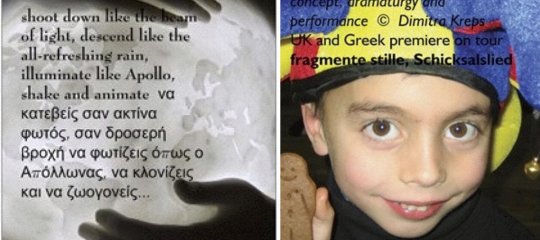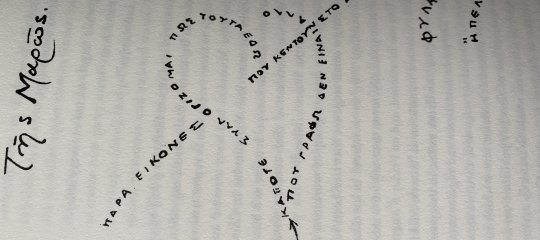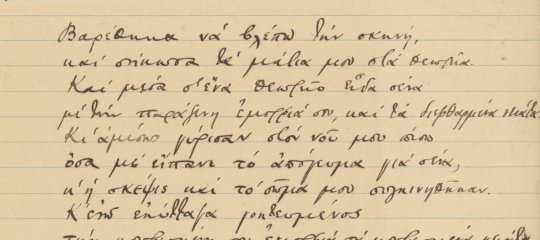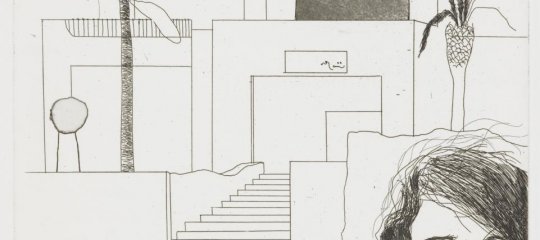«Examine how homoerotic love is expressed in Cavafy’s erotic poetry» By Yousuf Danawi, Reading University
«Examine how homoerotic love is expressed in Cavafy’s erotic poetry»
By Yousuf Danawi, 2nd year Classics student at the University of Reading
Supervisor: Dr Dimitra Tzanidaki-Kreps, University of Reading
Title photo: Cavafy’s manuscript of the hidden poem ‘At the theatre’, the Onassis foundation digital archives
This essay aims to examine the manner in which homoerotic love is expressed in Constantine Peter Cavafy’s erotic poetry.Initially, it will provide a brief introduction entailing contextual information. Subsequently, this essay will bestow an intricate analysis of his erotic poems, with a particular focus on elucidating recurrent themes pertaining to homoerotic love. The analysis will explore both the formal and thematic constituents of Cavafy’s erotic poetry, accompanied by a pervading extraction of deeper meaning.This examination will be enhanced utilising relevant secondary literature. The primary source that consists of the poems to be discussed in this essay derives from a digital anthology that comprises Cavafy’s ‘Recognised’, ‘Denounced’, and ‘Hidden’ poems. As a result, the poems in question will, henceforth, be cited employing a term relevant to the website. Namely, ‘See snhell’.
Cavafy was a late nineteenth-century and early twentieth-century Greek poet. He spent the majority of his life living in the city of Alexandria in Egypt. Cavafy also lived in England and Constantinople (modern-day Istanbul) for a considerable period of his youth (See Robinson 1988: 1). Owing to the preponderance of posthumously published erotic poems, it has been, arguably erroneously, presupposed that much of Cavafy’s erotic poetry was composed later in his life when he“came to terms with his homosexuality”. Howbeit, a close examination of the known dates of composition and publication demonstrates that a significant portion of his erotic poems were, in fact, composed from the onset of his career (approximately 1892). By 1904, Cavafy had written a substantial amount of erotic poems which he willinglywithheld from circulation, potentially in fear of society expressing severe disapproval at their homosexual nature. However, his disinclination to publish his poetry has been conveyed to be resulting from his perfectionist disposition and desire to allow his poems to develop over long periods of time. One potential piece of evidence in support of the notion that Cavafy’s poetry reflected his own sexuality is his four erotic poems pertaining to the year 1903. This is because 1903 happens to be the year that Cavafy had an encounter with a man named Alexander Mavroudis in Athens. This is noteworthy due to the fact that the initials “A.M.” are inscribed on the original manuscript of the poem ‘September 1903’ (See Alexiou 1983: 48-50). Albeit, Cavafy can be perceived as a master of adopting the persona of other individuals. This is patently evidenced by his historical poems where he takes on the persona of historical figures such as that of a Christian in the ancient Greek city of Antioch during the reign of Julian of Antioch in 361-363 AD (See Keeley 1983: 160). On account of the ambiguity pertaining to whetherCavafy’s erotic poems reflected his personal life and sexuality, this essay will, hereafter, refer to the individuals in question as the ‘subjects’ of his poems. To reiterate, this essay aims to explicate the manner in which homoerotic love is poetically expressed in lieu of attempting to make inferences concerning Cavafy himself.
Cavafy was evidently inclined to place a pronounced importance on the conceptualisation of beauty and aesthetic pleasure when he composed his erotic poetry. This serves as evidence that eroticism is fundamentally a “matter of art” for Cavafy (See Jusdanis 1987: 96). The subjects of his erotic poems routinely focus on the appearance of their romantic orsexual interests. For example, in the poem entitled ‘December 1903’, the subject mentions the hair, lips, eyes, and face of their person of interest (See snhell). Furthermore, the entiretyof the poem entitled ‘So I stared a lot’ is dedicated to the subject’s appreciation of their person of interest’s beauty (See snhell). The subject likens the hair of their person of interest to that of “Greek statues”. It is a renowned notion that Classical Greek sculptures were idealistic in nature as their sculptors deliberately produced them in an idealised manner. This means that Classical Greek sculptures were a depictionof perfection rather than reality (See Smith and Plantzos 2012: 116). Consequently, by comparing their person of interest to Greek sculptures in respect of their beauty, the subject inexorably identifies that person with a collective of figuresthat once epitomised the conceptualisation of aesthetic perfection in a society. Namely, Classical Greece. Thishighlights the leitmotif of beauty which is ever-present in Cavafy’s erotic poetry. This could imply that beauty or potentially physical perfection is a prerequisite for experiencing homoerotic love. Homoerotic encounters are exclusively attainable, or perhaps appreciably more accessible, by those who satisfy the conditions of what is considered to be aesthetically pleasing.
In addition, the fact that the subject is impelled to describe thebeauty of their person of interest by comparing them toanother figure of beauty detracts from that person’s individuality. As a result, this undermines the beauty of that person. This is because it demonstrates that the person in question is merely appreciated on account of their likeness with other beautiful men. There is no acknowledgement or admiration for the person’s originality and uniqueness, not to mention their non-aesthetic qualities such as their personality. This hints at the superficial essence of this recurrent theme of physical appearance in Cavafy’s erotic poetry. This is by virtue of the fact that this type of treatment of beauty can be arguably perceived as objectifying in nature. There is aheightened significance placed upon the beauty of the people of interest to the subjects of Cavafy’s erotic poems. Thisrenders them sexual objects who adopt the function of satisfying the sexual desires of the subject, whether that be in the physical realm or within the subject’s imagination.Therefore, the erotic interests of the subjects are sexually objectified owing to their potentially unwilling albeit inevitable ability to provide sexual arousal for the subject.
This is evocative of another one of Cavafy’s poems in which the theme of physical appearance is present. Namely, ‘Half anhour’ (See snhell). In this poem, the subject states that they needed to see the lips of their person of interest regardless of the capacity of their imagination. This implies that physical sensory experience is a requirement to enable the imagination.In other words, the subject must be able to observe their person of interest in order to gain sexual satisfaction and arousal through means of their imagination. The subject is essentially envisaging sexual activity with their person of interest within the metaphysical realm of their mind. This perpetuates the recurring element of sexual objectificationpresent in Cavafy’s erotic poetry. Albeit, the fact that imagination and fantasy is also a motif in Cavafy’s erotic poetry could also be an implicit commentary concerning the censorious societal attitudes towards homosexuality during the period of time in which Cavafy lived. This is because it may be highlighting the limits to which men with homoerotic tendencies could satisfy their sexual desires. Namely, their desires being primarily restricted to the mental andimaginative sphere.
This feature of sexual objectification is further accentuated, once again, by the comparison of the subject’s person of interest to “Greek statues” in ‘So I stared a lot’. This is on account of the fact that the subject not only identifies their person of interest with a collective of figures that were considered aesthetic perfection at one point in time, but also identifies them with actual inanimate objects by doing so.This is a clear manifestation of objectification. More importantly, Greek sculptures are objects of historical interest as they are relics of antiquity. Consequently, they are customarily exhibited in museums to be observed and inspected by an audience for purposes of personal intrigue and pleasure. This has a parallel with the circumstances of the poem in question. This is because the subject evidently observes them in the same manner as an individual viewing an artefact in a museum, albeit rather as an object of sexual interest in lieu of historical interest. Thus, homoerotic love is largely expressed through appreciation of physical appearance. The implication of this is that it is in turn portrayed as being merely a matter of sexual satisfaction rather than romance and love.
Furthermore, we are aware that the subject compliments their erotic interest’s hair in ‘So I stared a lot’, likening it to that of Greek sculptures. Howbeit, the subject does this in terms of the fashion in which it is combed and slightly falls on their “white foreheads”. The fact that the subject mentions both Greek statues and a white complexion renders this allusive to the Pygmalion myth. The narrative of this myth is as follows: a man named Pygmalion sculpts a statue of a female out of ivory that he names Galatea. This followshis recently established lack of interest in women in light of the knowledge that the Propoetides(priestesses of the goddess Venus) were engaging in prostitution. As a result of their lack of shame,Venus punishes them by depriving them of the ability to blush. This renders the blood in their cheeks solid causing them to transform into stone. Pygmalion falls in love with his statue and Venus eventually transforms it into an animate being (Ovid, Metamorphoses 10.220-297). The parallel between this poem and the Pygmalion myth resides in the fact that Pygmalion sculpts a statue that he falls in love with out of ivory, which is known to be white in colour, and that he names the statue Galatea. This is because the name ‘Galatea’translates to ‘milk-white’ (See March 2014). Thus, we can observe that the feature of whiteness is foregrounded in the Pygmalion myth. The subject also positively highlights the characteristic of white complexion in their erotic interest. Therefore, this may be indicative of racist undertones. This is because it seems to be an implicit commentary in favour of white supremacy. It extends the notion of the superiority of whiteness to the sphere of beauty by suggesting that an aesthetically pleasing appearance is characterised by a white complexion. Consequently, this may be a glorification of colourism. The subject is expressing homoerotic love through their praise of their erotic interest’s whiteness which perpetuates the previously implied notion that homoerotic encounters are predominantly attainable by those who satisfy the conditions of what it meant to be beautiful according tosociety. This could also suggest that homoerotic love was a luxury that was exclusively available to the more privileged members of society.
Moreover, the fact that the subject alludes to the Pygmalion myth, a narrative in which prostitutes are a prominent feature, may implicitly comment on the status of the erotic interest. Namely, that they are an escort. This is corroborated by the fact that there were numerous brothels in Alexandria, where Cavafy lived most of his life, that catered to both the heterosexual and homosexual desires of their clients (See Alexiou 1983: 54). Cavafy’s place of residence in Alexandria was in close proximity to these brothels. It has been contended that Cavafy formulated the narratives of his erotic poems based on the sexual encounters between clientele and prostitutes that he used to observe from his balcony (See Keeley 1976: 52-54). Therefore, it is probable that the erotic interests in Cavafy’s erotic poems possessed the status of a courtesan. As a result, homoerotic love is expressed as an experience that is only accessible through means of secretive practises such as prostitution. Thus, it is also depicted as a phenomenon that is principally experienced via sexual activity in comparison to naturally occurring romantic relationships.This may further hint at the limitations of homoerotic love in the society in which Cavafy lived owing to the likely possibility of severe disapproval.
This evokes other prominent leitmotifs in Cavafy’s erotic poetry. Namely, recollection, hesitation, and imagination. For example, the subject in the poem entitled ‘Love Listening’ to remember what “your imagination created you” and then the“smaller ones – that you went through in your life” (See snhell). This implies that the tangible experiences had in actuality are inferior to those that can be fabricated utilising the skill of imagination. Thus, imagined erotic encounters are preferable. It is probable that this is by virtue of the fact that real-life homoerotic experiences were met with difficulties.This may be highlighting that individuals with homoerotic desires resorted or were limited to their imagination rather than realising their desires. Perhaps this is because they feltmore secure attempting to satisfy their desires in the metaphysical realm due to the impossibility of risk.Consequently, homoerotic desire is expressed as something that can primarily be entertained within the confinements of the mind. They also possessed the ability to create the perfect reality in their mind, which may not be as attainable in the circumstances of reality, especially in a society where the nature of their desires was likely to be censured. Therefore, this could be hinting at the status of societal attitudes towards homosexuality. Notably, this is one example of juxtaposition, a poetic device repeatedly employed in Cavafy’s erotic poetry. In this case, we can observe a contrast between fantasy and reality.
Moreover, in the poem entitled ‘Days of 1903’, the subject, in a nostalgic sombre tone, elucidates that they “never found again” the chances at realising their desires, which they willingly relinquished in spite of the great extent to which they craved this (See snhell). Therefore, the subject is expressing deep regret concerning their loss of a potential opportunity. This highlights the theme of hesitation present in Cavafy’s erotic poems. The subject, for the second time, describes the “poetic eyes” and “pale face” of their person of interest. This creates a sense of repetition is a poetic manifestation underscoring the fact that the subjects of Cavafy’s erotic poetry tend to replay memories and past experiences in lieu of creating new ones.
This concept of replaying memories is primarily carried out in a regretful or reminiscent manner. For example, in the poem entitled ‘The afternoon sun’, a description of the interior design of the place where the subject and their sexual partner made love “so many times” is provided (See snhell). Theintricacy of the description, including features such as a “Turkish rug”, outlines the extent to which the subject relies on living in the past to provide momentary satisfaction. The subject ends with explaining that they became separated forever. This hints at an impermanence of relationships that were homosexual in nature. This could suggest that the participants in homosexual relationships felt that they could not continue their relations into the long term, plausibly due to the challenges that resulted from the harsh reality of an anti-homosexual society. Thus, relationships of these nature had to be kept short and sweet. Hence, men with homoerotic desires relied on the temporary positive emotions that recollection brought them. Therefore, homoerotic love is expressed as a fleeting experience that unfortunately comes to a sudden, unwelcomed end.
The highly irregular stanza length in ‘The afternoon sun’could hint at the lack of balance, confusion, and negative emotions experienced by men with homoerotic desires, resulting from this unjust reality described. The fact that the subject predominantly lives in the mind means that they are susceptible to overthinking and negative thought patterns. The irregularity present in the length of the stanzas could be a poetic manifestation of this.
In addition, the poem ‘Half an hour’ also expresses regret at a lost opportunity for a potential sexual encounter. The subject states that they had “half an hour of perfect sex” via the“intensity of the mind” by gazing at their erotic interest (See snhell). The description of the sex as ‘perfect’ accentuates the previously suggested notion that homoerotic desires can only be experienced in a perfect manner through the metaphysical realm. Cavafy adopts enjambment which enhances the sexually charged nature of this poem. This is because it elicits a sense of heavy breathing and loss of breath which is evocative of the essence of sex as an act. Further, the repeated use of caesurae creates irregular breaks and disrupts the flow of the poem. This evokes the nature of the situation at hand. The subject, since being hesitant to act upon their desire, utilises their mind to imagine sex with their erotic desire. This requires concentration. Therefore, the caesurae could be a poetic manifestation of the repeated sudden breaks between living out a fantasy in the mind and returning to reality.
We can also observe the motif of hesitation in this poem. This hesitation is arguably the cause of the patent obsessive use of recollection to relive sexual encounters for pleasure and imagination as a substitute for sex in actuality. As previously stated, this sheds light upon the attitudes of the society in which Cavafy composed these erotic poems. Michel Foucault established the concept of the ‘Repressive hypothesis’. Foucault asserts that from the Victorian era, a period in which Cavafy lived, to the present day, there has been a considerable amount of repression of sexuality. Homosexuality was still taboo prior to the Victorian period, albeit discussion of it was not as frowned upon (See Kelly 2013: 16). Therefore, this extent of condemnation towards homosexuality explains the austere hesitation to satisfy homoerotic desires experienced by the subjects of Cavafy’s erotic poems. The heavy use of juxtaposition between fantasy and reality or activity and passivity creates a pervading sense of contrast. This is a true poetic manifestation of the conflict experienced by the subjects in their desire for homoerotic love but simultaneous inability to garner the bravery to do so in a society which rebukes them for their very essence of being.
In conclusion, homoerotic love is largely expressed through appreciation of physical appearance in a way that suggests that it is predominantly experienced by those who satisfy the conditions of beauty, according to society. This implication and the manner in which it is expressed can be perceived as objectifying and discriminatory. It is also expressed as something secretive in nature and experienced primarily through sexual activity. Finally, it is portrayed as possessing limits and challenging to attain owing to society’s censorious attitude towards homosexuality. This is accentuated through the leitmotifs of imagination, recollection, and hesitation.
Bibliography
Primary Sources:
Center for Neo-Hellenic Studies: Modern Greek Literature and Culture [Greece, English Version]
(accessed 9 December 2020).
http://www.snhell.gr/anthology/writer.asp?id=60
Ovid, Metamorphoses, Volume II: Books 9-15, translated by Frank Justus Miller (Cambridge 1916)
Secondary Sources:
Alexiou, M. (1983) ‘Eroticism and Poetry’, Journal of the Hellenic Diaspora 10, 45-65.
Jusdanis, G. (1987) The Poetics of Cavafy: Textuality, Eroticism, History. Princeton.
Keeley, E. (1976) Cavafy’s Alexandria. Princeton.
Kelly, M. G. E. (2013) Foucault’s History of Sexuality Volume I, The Will to Knowledge. Edinburgh.
March, J. R. (2014) Dictionary of Classical Mythology. Oxford.
Robinson, C. (1988) C. P. Cavafy: Studies in Modern Greek. Bristol.
Smith, T. J. and Plantzos, D. (2012) A Companion to Greek Art. Oxford.
- Εισέλθετε στο σύστημα για να υποβάλετε σχόλια










